
Fifth stage
Pediatric
Lec-1
.د
خليل
19/10/2016
The cardiovascular system
Congenital Heart Disease
Epidemiology:
• Heart disease in children is mostly congenital.
• 8 per 1000 live-born infants have significant cardiac
malformations
• About 10% of stillborn infants have a cardiac anomaly.
Etiology of congenital heart disease
• Little is known about the etiology C.H.D.
• A small proportion are related to external teratogens
• About 8% are associated with major chromosomal abnormalities.
• Polygenic abnormalities probably explain why a previous child
with congenital heart disease doubles the risk for subsequent
children and the risk is still higher if either parent has congenital
heart disease.
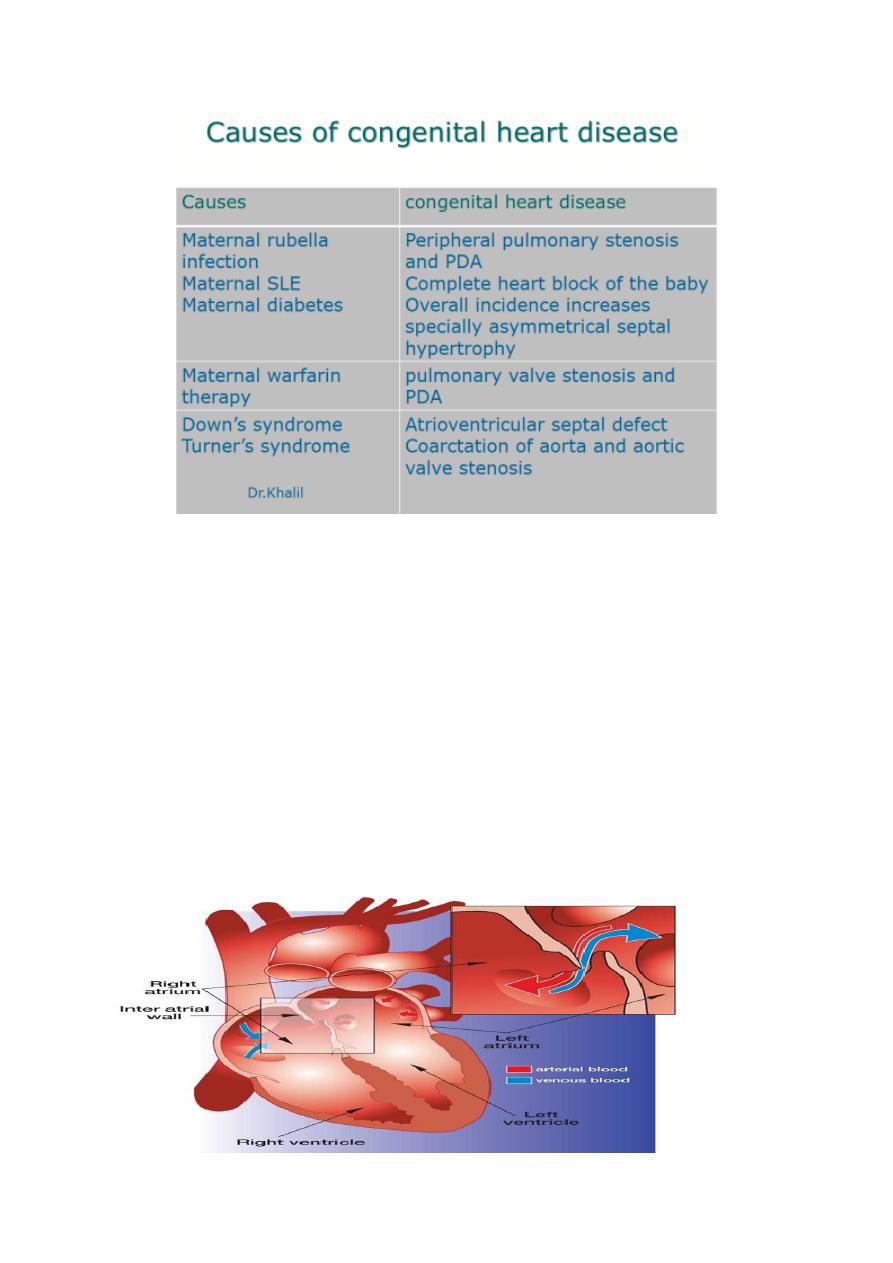
Circulatory changes at birth
• In the fetus, the left atrial pressure is low, as relatively little blood
returns from the lungs.
• The pressure in the right atrium is higher than in the left, as it
receives all the systemic venous return including blood from the
placenta.
• The ductus arteriosus shifts the blood from the pulmonary artery
to the aorta.
• The flap valve of the foramen ovale is held open, blood flows
across the atrial septum into the left atrium and then into the left
ventricle, which in turn pumps it to the upper body.
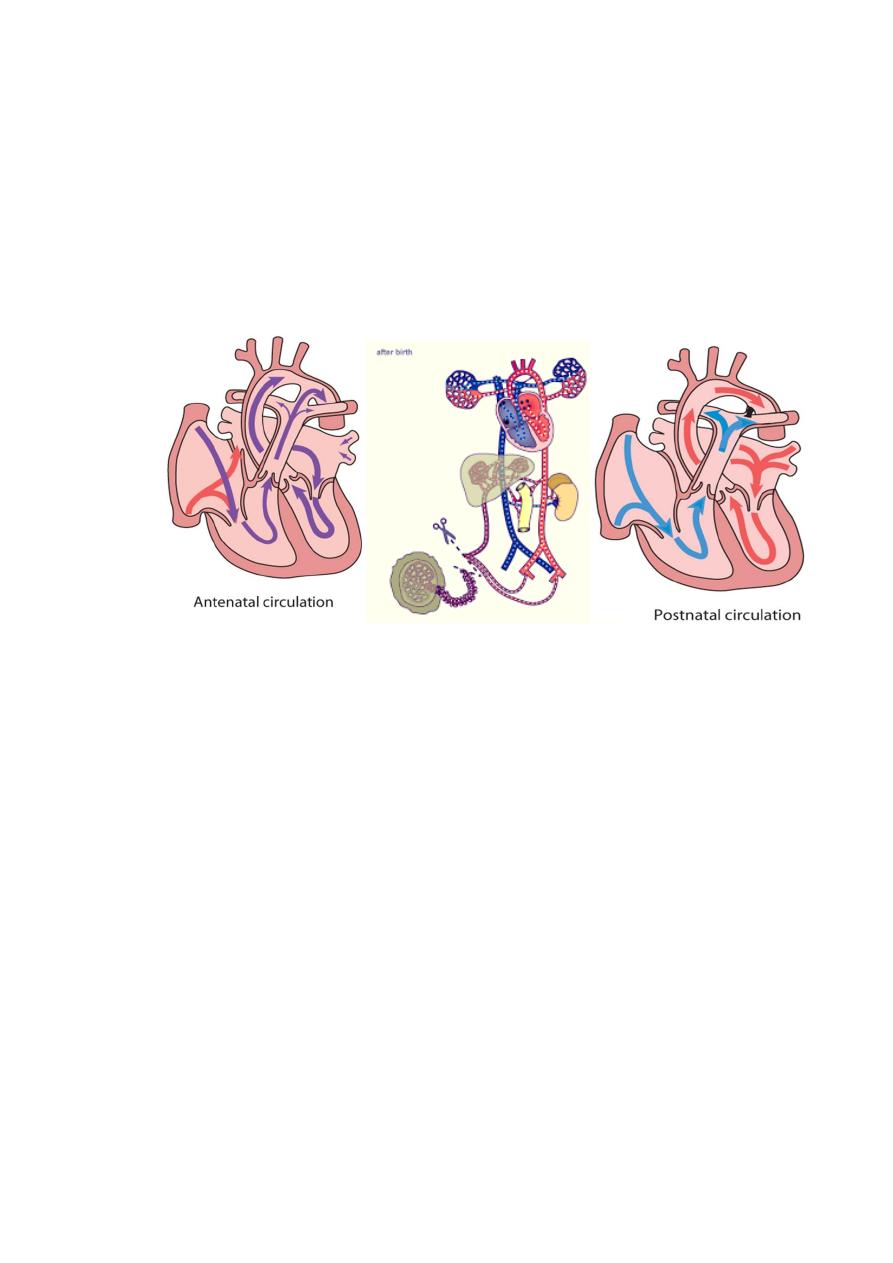
• With the first breaths, resistance to pulmonary blood flow falls
and the volume of blood flowing through the lungs increases
sixfold. This results in a rise in the left atrial pressure. Meanwhile,
the volume of blood returning to the right atrium falls as the
placenta is excluded from the circulation. The change in the
pressure difference causes the flap valve of the foramen ovale to
be closed. The ductus arteriosus will normally close within the first
few hours or days.
Presentation
:
Congenital heart disease could present in any way of the followings:
o Antenatal cardiac ultrasound diagnosis
o Detection of a heart murmur
o Cyanosis
o Shock.
o Heart failure
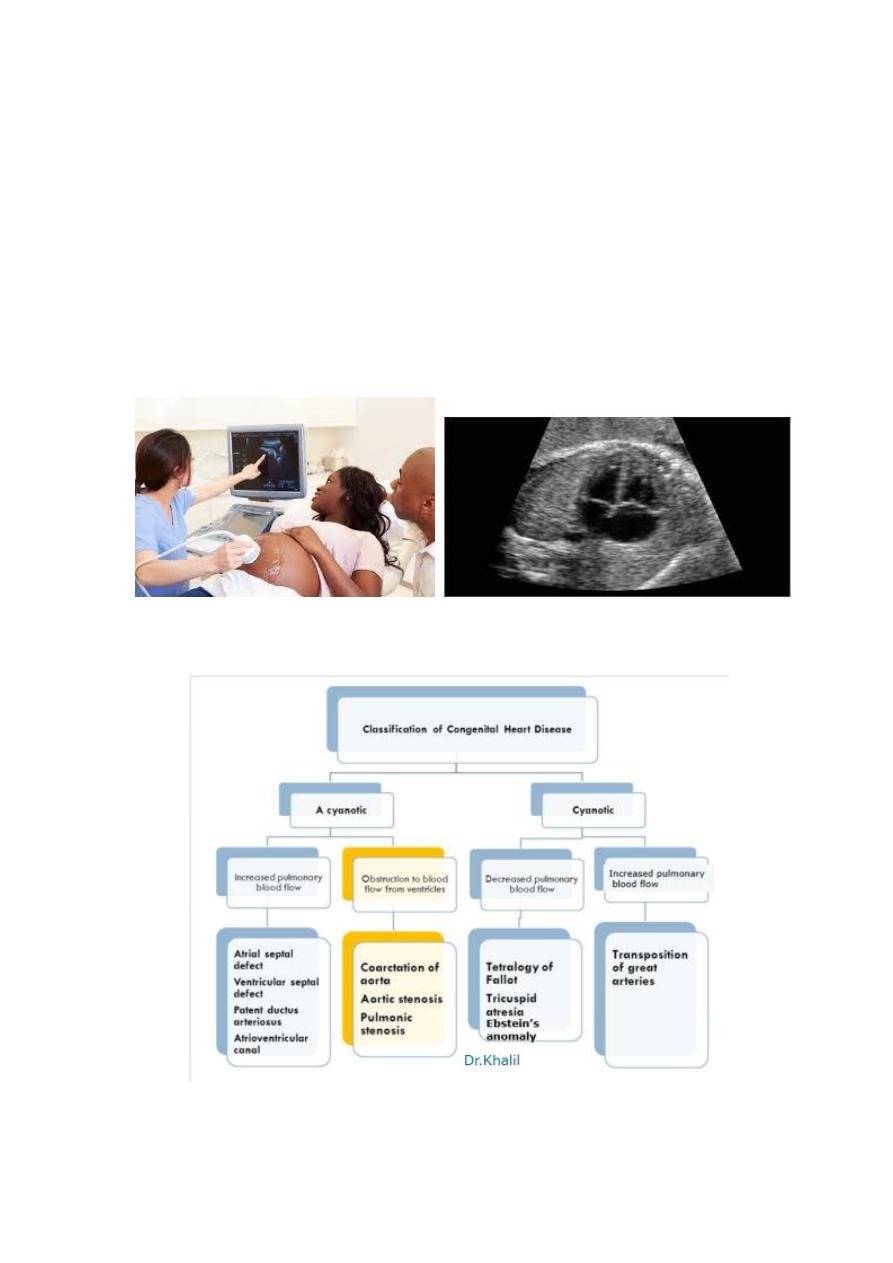
Antenatal diagnosis
Fetal anomaly scan is performed between 18 and 20 weeks' gestation.
If an abnormality is detected, detailed fetal echocardiography is
performed by a paediatric cardiologist, who also checks any fetus at
increased risk, e.g. where Down's syndrome is suspected, where the
parents have had a previous child with heart disease or where the
mother has C.H.D. The continuation of pregnancy and delivery then
planned.
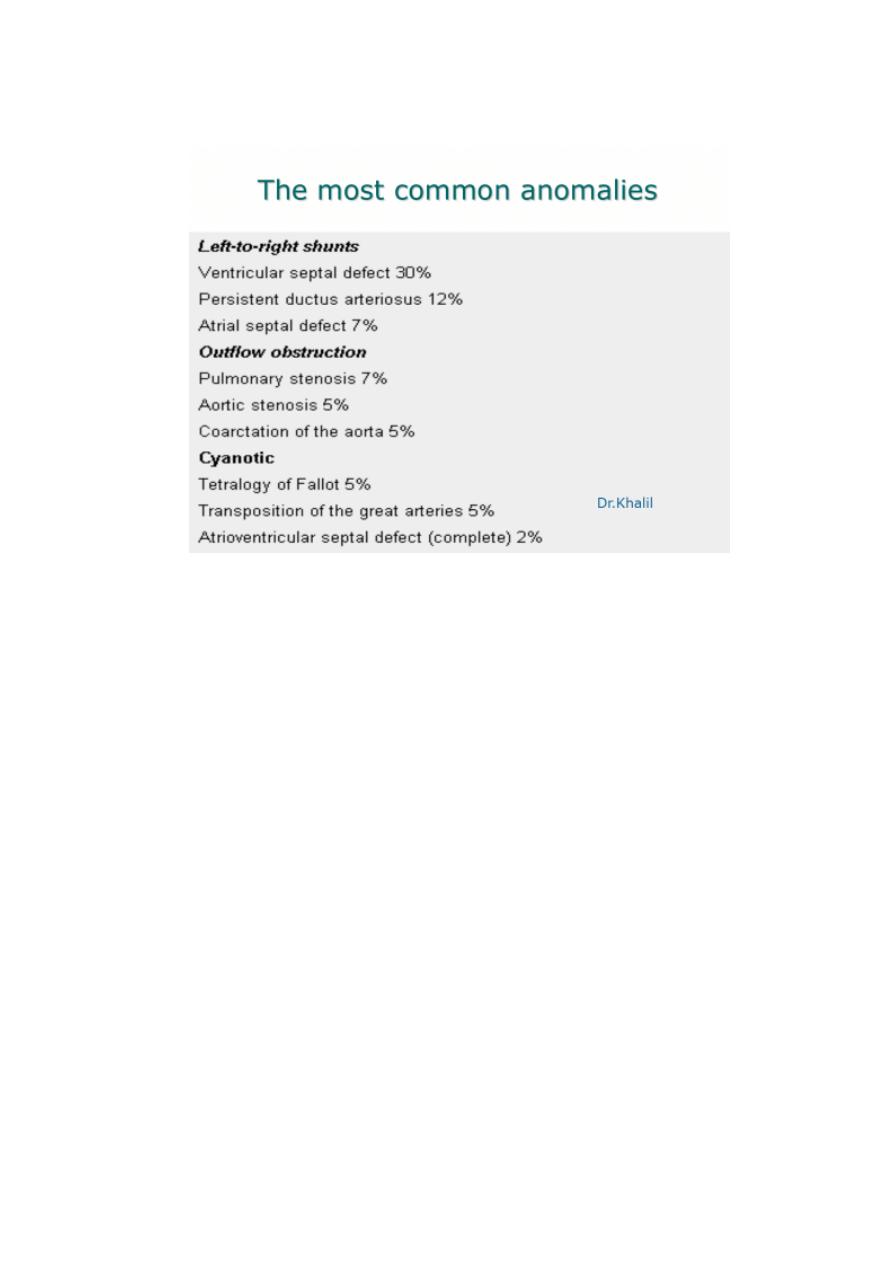

Obstructive (stenotic lesions)
Coarctation of aorta
It is constrictions of the aorta just below the origin of the left
subclavian artery at the origin of the ductus arteriosus.
Etiology and Epidemiology
During development of the aortic arch, the area near the insertion of the
ductus arteriosus fails to develop correctly,resulting in a narrowing of
the aortic lumen. This leasion forms 5-10% of all congenital heart
defects.
Clinical Manifestations
The more the severe the narrowing the earlier the presentation.
Infants present with poor feeding, respiratory distress,and shock
and may have hypoplastic aortic arch with VSD.
Older children re usually asymptomatic or presenting With leg
discomfort with exercise, headache, or epistaxis.
On examination
A-Decreased or absent lower extremity pulses
B-Upper extremity hypertension.
C-Murmur may be present which is systolic and best heard in the left
interscapular area of the back. If significant collaterals have
developed, continuous murmurs may be heard throughout the chest.
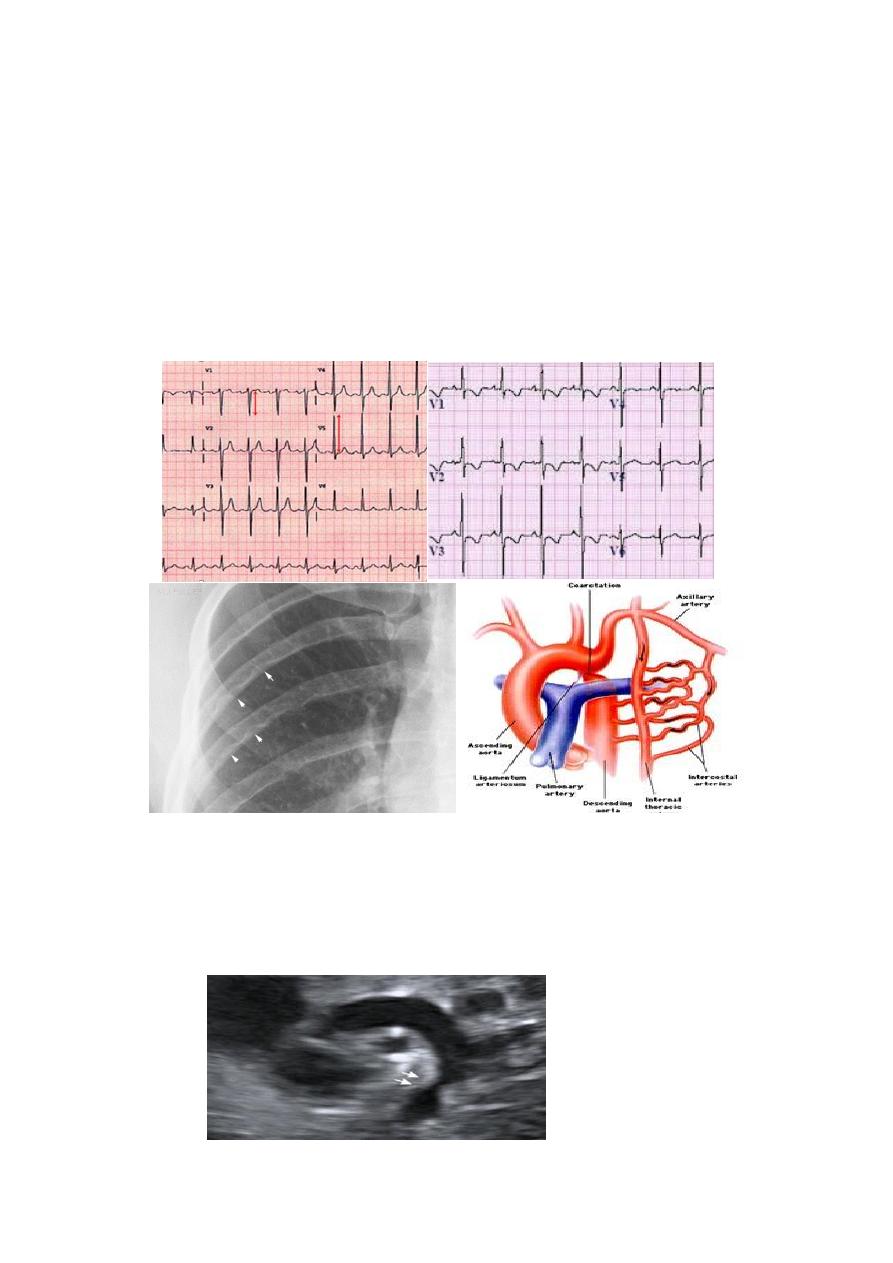
Investigations
1- In infantile type ECG and CXR show right ventricular hypertrophy
with cardiomegaly and pulmonary edema while in older children
they show left ventricular hypertrophy and a mildly enlarged heart
In older children(>8 years) the chest x-ray film may show notching
of the ribs due to the development of collaterals.
2-Echocardiography shows the site and degree of coarctation, presence
of left ventricular hypertrophy, and aortic valve morphology and
function
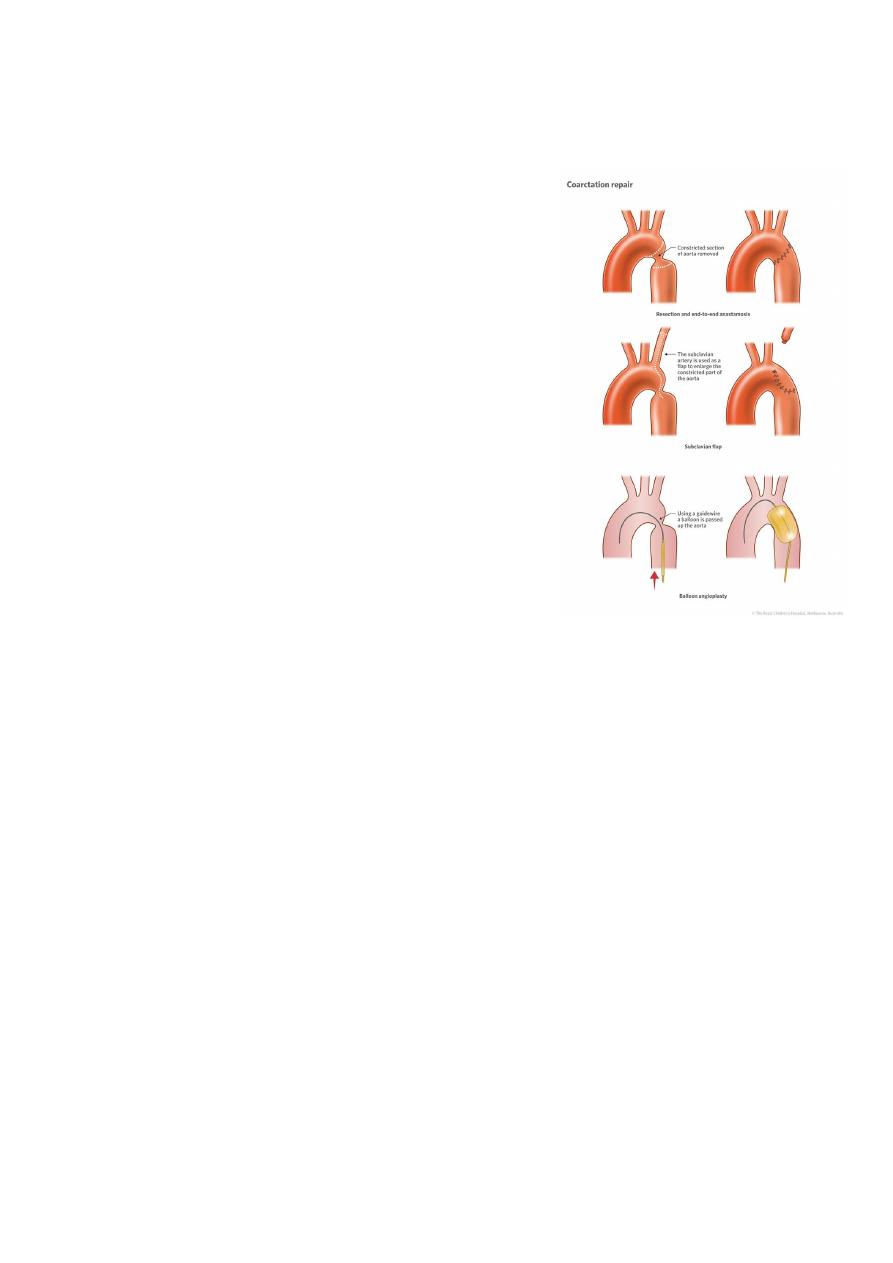
Treatment
1. In infants management of heart failure
and PGE2 infusion to maintain ductus
patency then balloon dilatation or
surgical repair.
2. In older children balloon dilatation and
stenting or surgical repair.
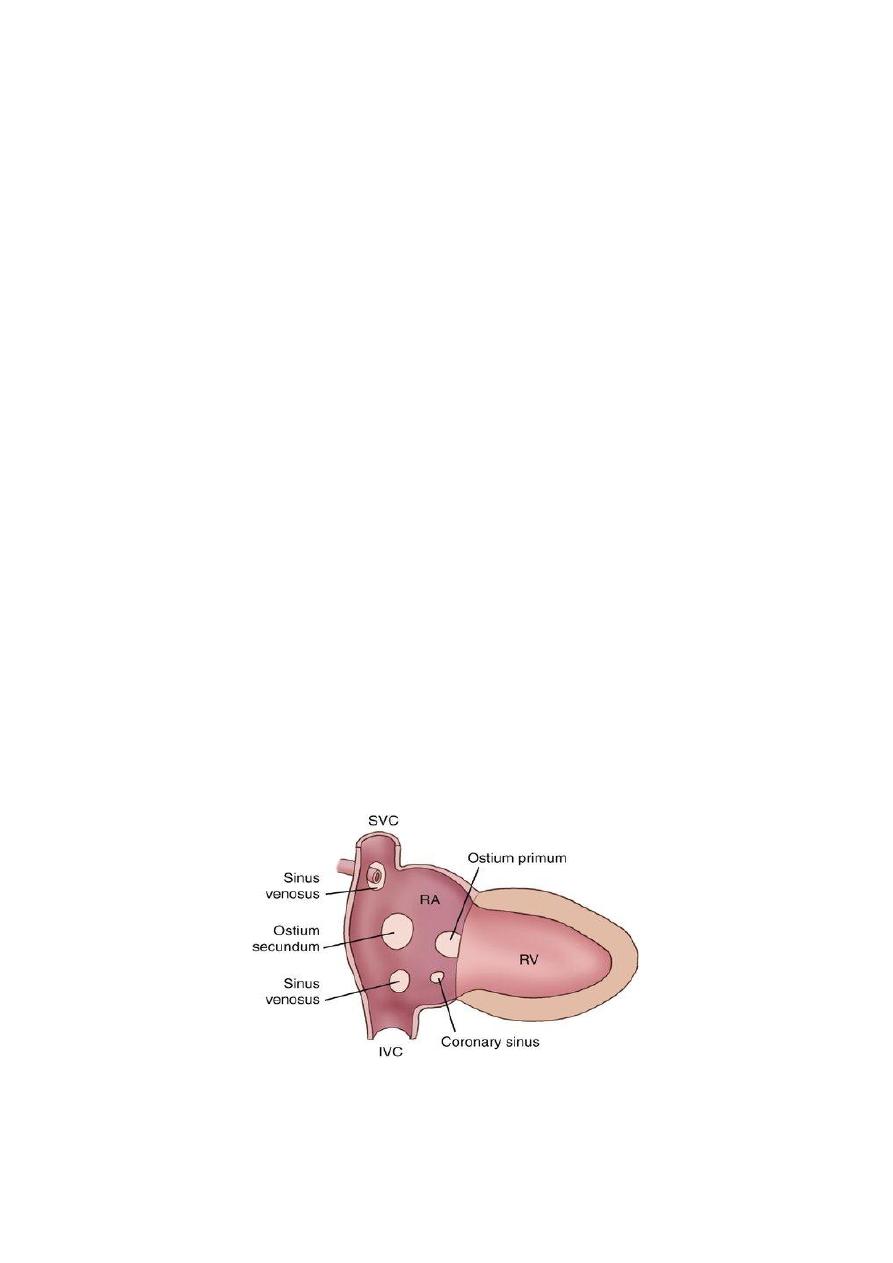
Acyanotic Congenital Heart Disease with increased pulmonary blood
flow (Left-to-right shunts)
Atrial Septal Defect
PREVALENCE
• ASD (ostium secundum defect) occurs as an isolated anomaly in 5
% to 10% of all congenital heart defects.
• It is more common in females than in males (male/female ratio of
1:2).
PATHOLOGY ;
1- Ostium secundum defect is the most common type of ASD,
accounting for 50% to 70% of all ASDs. This defect is present at the site
of fossa ovalis, allowing left-to-right shunting of blood from the left
atrium to the right atrium
2- Ostium primum defects occur in about 15-30% of all ASDs.
3- Sinus venosus defect occurs in about 10% of all ASDs.
The defect is most commonly located at the entry of the superior vena
cava (SVC) into the RA (superior vena caval type) and rarely at the entry
of the inferior vena cava (IVC) into the RA (inferior vena caval type).
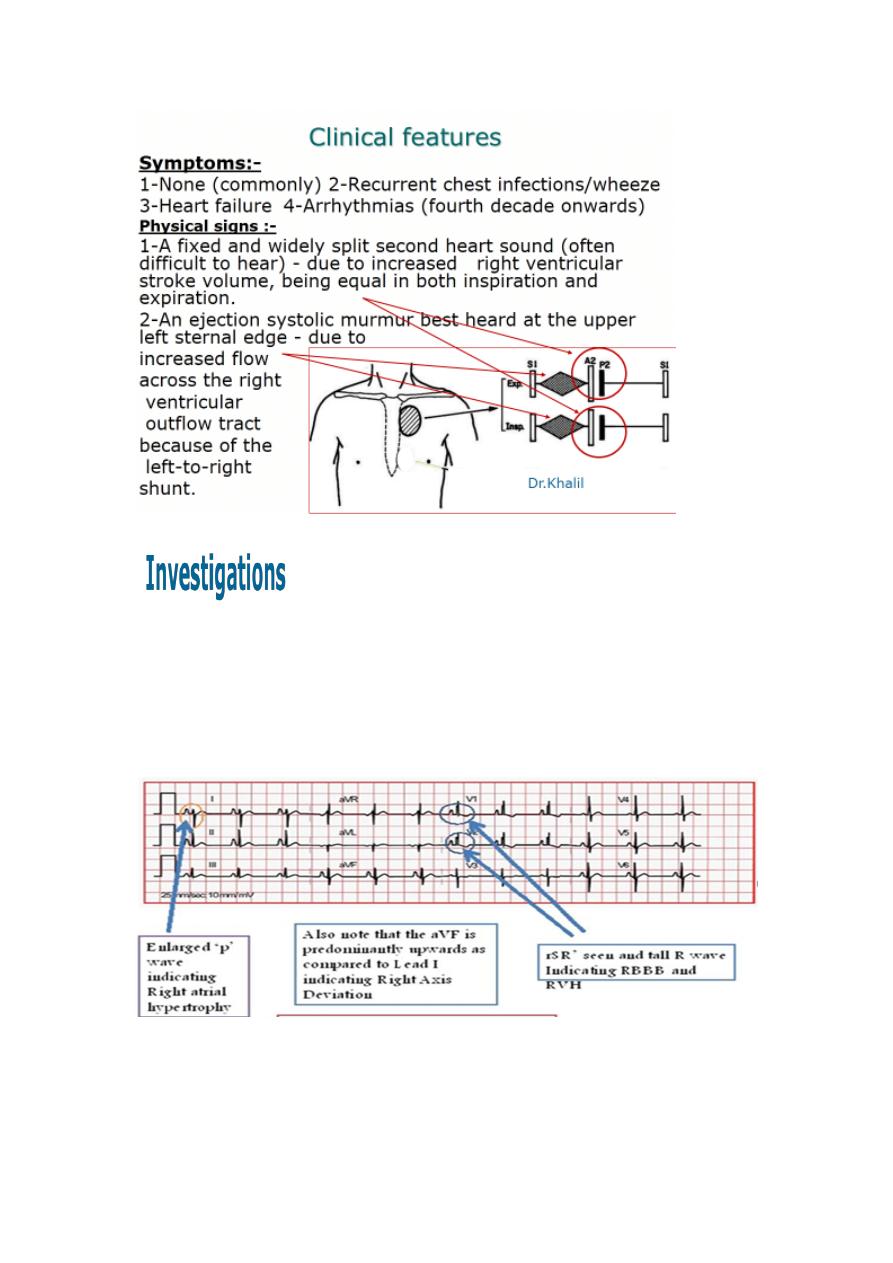
1-E.C.G
Right axis deviation of +90 to +180 degrees and mild right ventricular
hypertrophy (RVH) or right bundle branch block (RBBB) with an rsR'
pattern in V1 are typical findings
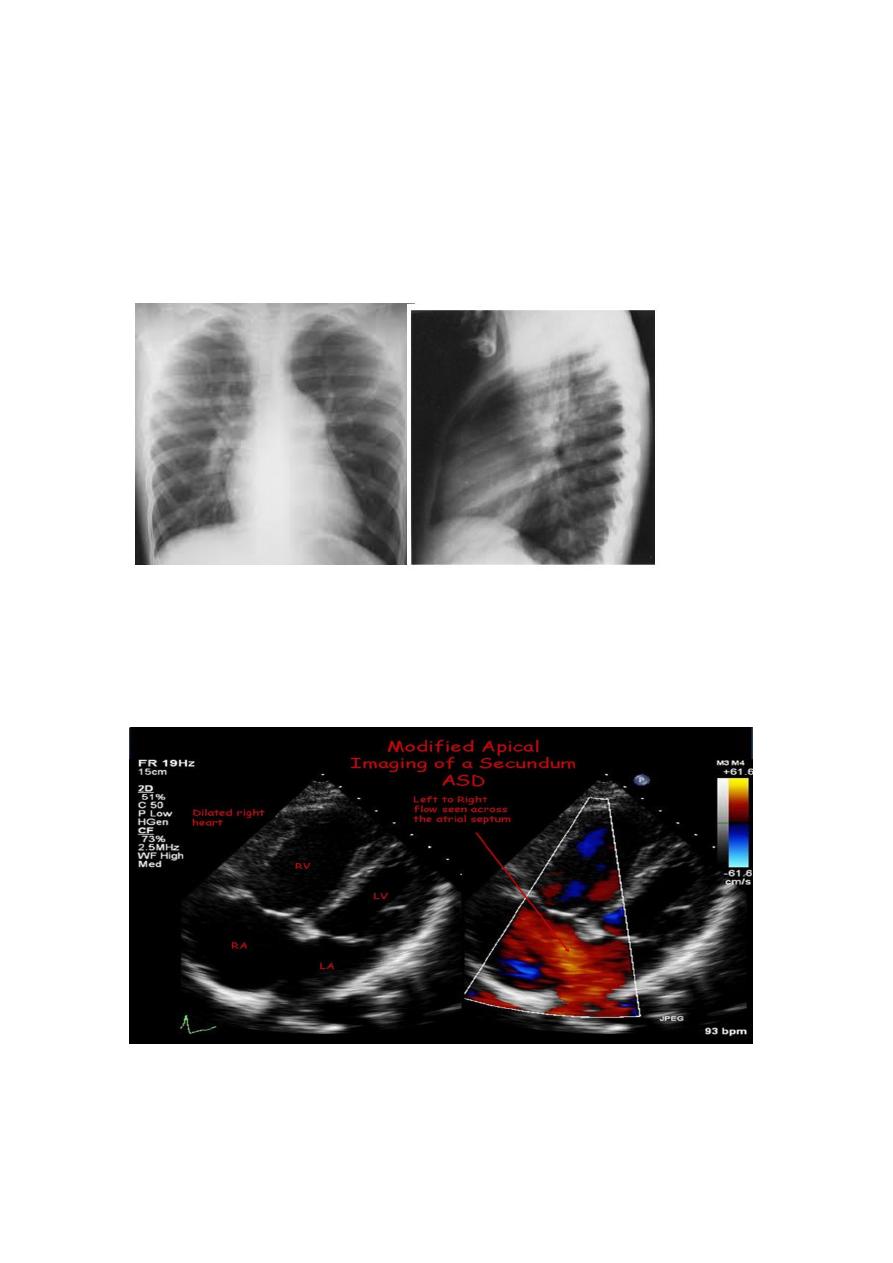
2-X-ray Studies
Cardiomegaly with enlargement of the RA and right ventricle (RV)
may be present.
A prominent pulmonary artery (PA) segment and increased
pulmonary vascular markings are seen when the shunt is
significant
3-Echocardiography
The location and size of the atrial defect are readily appreciated by two-
dimensional scanning . The shunt is confirmed by pulsed and color flow
Doppler .

NATURAL HISTORY :
With ASD less than 3 mm in size diagnosed before 3
months of age, spontaneous closure occurs in 100% of
patients at 1½ years of age. Spontaneous closure occurs in
more than 80% of the time in patients with defects
between 3 and 8 mm before 1½ years of age. An ASD with
a diameter greater than 8 mm rarely closes
spontaneously.
Most children with an ASD remain active and
asymptomatic. Rarely, congestive heart failure (CHF) can
develop in infancy
If a large defect is untreated, CHF and pulmonary
hypertension develop in adults who are in their 20s and
30s.
With or without surgery, atrial arrhythmias (flutter or
fibrillation) may occur in adults.
Infective endocarditis does not occur in patients with
isolated ASDs.
Cerebrovascular accident, resulting from paradoxical
embolization through an ASD, is a rare complication.
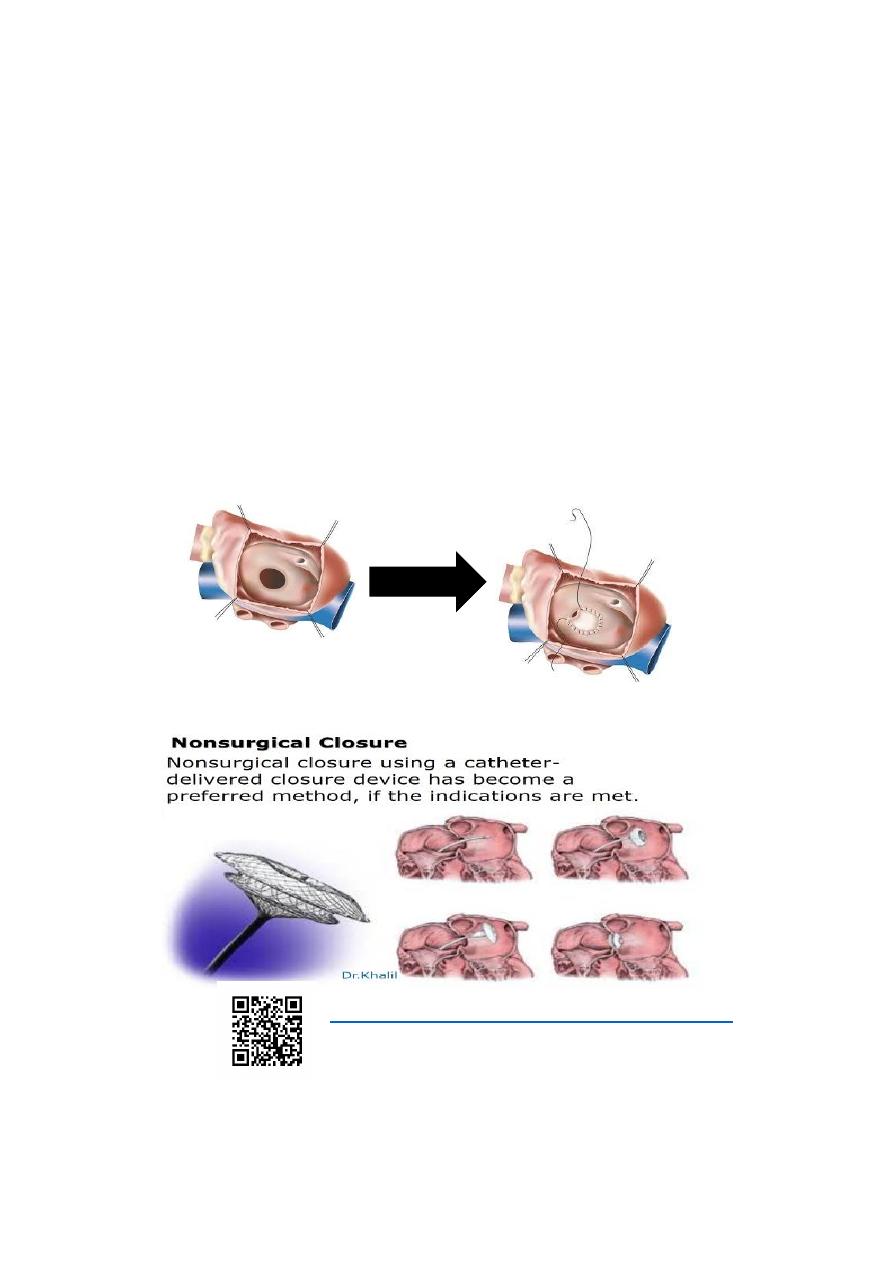
MANAGEMENT:
Medical
Exercise restriction is unnecessary.
Prophylaxis for infective endocarditis is not indicated
unless the patient has mitral valve prolapse or primum
ASD.
In infants with CHF, medical management is
recommended because of its high success rate and the
possibility of spontaneous closure of the defect.
Surgical Closure.
It is done if device closure is not appropriate.
https://www.muhadharaty.com/lecture/13482
